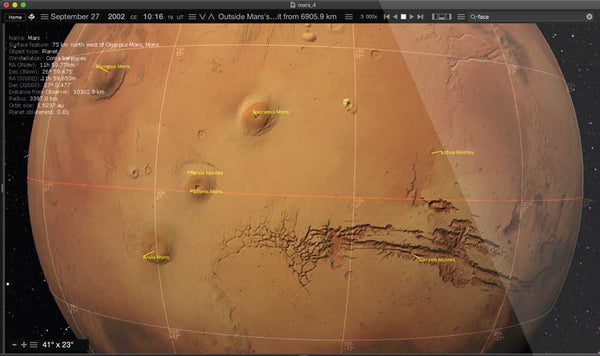

If the Sun could be seen from Venus's surface, the time from one sunrise to the next (a solar day) would be 116.75 Earth days. Color images taken by the Soviet Venera probes suggest that the sky on Venus is orange. Being closer to the Sun, Venus receives about 1.9 times more sunlight than Earth, but due to the thick atmosphere, only about 20% of the light reaches the surface. The atmosphere of Venus is so thick that the Sun is not distinguishable in the daytime sky, and the stars are not visible at night. The zodiacal light is probably more prominent than it is from Earth. All other planets are visible just as they are on Earth, but somewhat less bright at opposition with the difference being most considerable for Mars. The maximum apparent distance between the Earth and the Moon is about 15′. The Earth and the Moon are also very prominent, their apparent magnitudes being about −5 and −1.2, respectively. The apparent magnitude of Venus is as bright as −7.7.
#STARRY NIGHT PRO 5.8.4 FULL#
For a Mercurian observer, on the other hand, Venus is closest when it is in opposition to the Sun and is showing its full disk. Indeed, even when Venus is brightest in the Earth's sky, we are actually seeing only a narrow crescent. The reason for this is that when Venus is closest to Earth, it is between the Earth and the Sun, so we see only its night side. Other planets seen from Mercury Īfter the Sun, the second-brightest object in the Mercurian sky is Venus, which is much brighter there than for terrestrial observers. It is fainter than Earth's Polaris (α Ursae Minoris). Mercury has a southern pole star, α Pictoris, a magnitude 3.2 star. The observer's height must be taken into account when calculating the distance to the horizon.īecause Mercury has little atmosphere, a view of the planet's skies would be no different from viewing space from orbit. Thus, the horizon on Mercury is 62% as far away from the observer as it is on Earth, on Mars the figure is 73%, on the Moon the figure is 52%, on Mimas the figure is 18%, and so on. On terrestrial planets and other solid celestial bodies with negligible atmospheric effects, the distance to the horizon for a "standard observer" varies as the square root of the planet's radius. The Sun's apparent magnitude changes according to the inverse square law, therefore, the difference in magnitude as a result of greater or lesser distances from different celestial bodies can be predicted by the following formula: Astronomical objects may also be visible and can include natural satellites, rings, star systems and nebulas and other planetary system bodies. The atmosphere's density and chemical composition can contribute to differences in colour, opacity (including haze) and the presence of clouds. An extraterrestrial atmosphere, if present, has a large bearing on visible characteristics. The skies of Venus, Mars and Titan have been observed by space probes designed to land on the surface and transmit images back to Earth.Ĭharacteristics of extraterrestrial sky appear to vary substantially due to a number of factors. The only extraterrestrial sky that has been directly observed and photographed by astronauts is that of the Moon. In astronomy, an extraterrestrial sky is a view of outer space from the surface of an astronomical body other than Earth. Taken by Apollo 8 astronaut William Anders while in lunar orbit, December 24, 1968 Electronic Media Integration has been incorporated throughout the text by the use of icons to indicate where additional understanding can be gained through an animation or interactive.A historic extraterrestrial sky- Earthrise, the Earth viewed from the Moon.
#STARRY NIGHT PRO 5.8.4 SOFTWARE#
That technology media package includes: Starry Night Planetarium Software ARIS (text web site providing a complete online electronic homework and course management system) 23 Interactives (on ARIS) Animations (on ARIS). Pathways to Astronomy offers the most complete technology media support package available. With the short length of units, students can easily digest the material covered in an individual unit before moving onto the next unit. They can select individual units for exploration in lecture while assigning easier units for self-study, or they can cover all the units in full depth in a content-rich course. Professors can customize the units to fit their course needs. These units are woven together to flow naturally for the person who wants to read the text like a book, but it is also possible to assign them in different orders, or skip certain units altogether. The huge and fascinating field of astronomy is divided into 84 units.

Pathways to Astronomy breaks down introductory astronomy into its component parts.


 0 kommentar(er)
0 kommentar(er)
